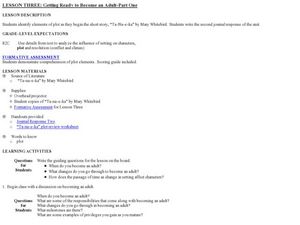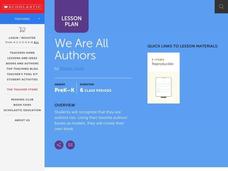Curated OER
Getting Ready to Become an Adult - Part One
Students read the book Ta-Na-e-ka and identify the elements of plot in the story. For this plot lesson plan, students also create a journal response to the story.
Curated OER
Story Retellings
Second graders complete story maps in order to retell stories to the class.
Curated OER
Fractured Fairy Tales
Through reading and writing, learners explore common elements found in fairy tales. After discussing traditional fairy tales, class members listen to The True Story of the 3 Little Pigs by John Scieszka, a hilarious retelling of the...
Curated OER
Reading the Play
Do figures of speech enhance a play or story? In small groups, learners locate and describe figures of speech they find while reading a reader's theater play. After making predictions, they describe how the figures of speech make the...
Curated OER
Through the Eyes of the Big Bad Wolf
Imagine how the wolf would tell the tale of Little Red Riding Hood or The Three Little Pigs. Young writers re-imagine classic tales by adopting the point of view of another character in the story. After reading models like The True Story...
Curated OER
Water Cycling in the Wilderness: Alaska quarter reverse
The Alaskan wilderness contains every imaginable element of the water cycle: it has flowing streams, cool spring rain, and frozen glaciers. Pupils use a series of worksheets to identify and define evaporation, condensation, and...
Curated OER
We Are All Authors
Read and discuss a variety of books by different authors and have your class create their own book. They will identify the different parts of a book, then using a story they have already written, they enter their story and information...
Curated OER
Genre Lesson: Biography/Autobiography
Practice distinguishing biography from autobiography through point of view. Tell a brief story of your morning. Have a class member retell the story to you (using second person). And have another retell the story to the class (using...
Curated OER
Fable Writing - Interdisciplinary Approach to Social Sciences
Before writing their own fables, class members select an animal or insect to use in their story and research its character, habits, movements, etc. After reading a wide variety of fables and identifying the elements of a fable, writers...
K20 LEARN
Let's Mail Away!: Writing Letters
Scholars watch a video or listen to a story about writing letters, then discuss their importance. A scavenger hunt challenges them to identify common elements of friendly letters and create an anchor chart. Pupils write letters to a...
Southern Nevada Regional Professional Development Program
Reading Literature - Romeo and Juliet
“What is the theme of this story?” Now there’s a question all pupils dread. Rather than encountering a sea of faces that look like they were painted by Edward Munch, face a classroom filled with smiles and confidence. Show your readers...
Curated OER
Parts of a Story
Students read a short fiction book and demostrate comprehension by identifying the main characters, setting, conflict, theme, and summarizing the main points. They organize the information in Inspiration and create a powerpoint to show...
Curated OER
Comparing Characters Across Two Short Stories
Ninth graders listen to a read aloud of two short stories focusing on literary devices. The write about the settings and realism of the stories, and decide each main character handles the conflict he faces with nature.
Curated OER
Identifing Elements of Narrative Writing
Young scholars explore the concepts of narrative writing. They identify the basic elements in narrative writing such as the setting description, characters, conflict, climax and resolution. Using five adjectives from a previous spelling...
Curated OER
Identifying the Problem and the Solution in a Story
Story elements: the problem and the solution. Help your youngsters identify these elements by reading Bringing Down the Moon, by Jonathan Emmett. After a class discussion and chart creation discussing problems and solutions from past...
Orange County Schools
Piggybook
Summarizing text is a balancing act between being brief but thorough. You need to be short and to the point, but also cover all the important details, a task that presents a challenge for many young learners. In this lesson based on the...
Curated OER
Language Conventions: Elements of a Good Log Entry
Students use writing logs to achieve clear and creative thinking about the story they are reading. They then describe changes in mood that happened in the story consider why such changes usually occur.
Curated OER
Life Size Characters
Sixth graders analyze character traits and create a life size character outline. In this character analysis lesson, 6th graders analyze character traits of a character using character webs and poems. Students then create a life size...
Curated OER
A Little Mystery and Intrigue in Writing Short Detective Stories
Learners read and analyze the twelve short stories in the novel "The Adventures of Sherlock Holmes." They create their own detective that has to solve a new kind of crime, and write and edit a short story with their original detective as...
Pennsylvania Department of Education
Exploring Key Ideas and Details in Fiction and Nonfiction
Third graders participate in activities to differentiate fiction from nonfiction. In this fiction instructional activity, 3rd graders describe the elements of a fiction story. Students compare and contrast fiction and non...
Curated OER
Understanding Character
Learners are introduced to literary elements and definitions in the worksheet Understanding Character but reading through each of the elements and definitions aloud. They read the story, "La Bamba" and identify examples of the literary...
Curated OER
Retell the "Tail" of the Tale
Students explore story structure. In this multicultural literacy lesson plan, students discuss common elements of folk tales and then listen to the story Tiger and the Big Wind: A Tale from Africa. Students identify the problem and...
Curated OER
Creating a Book Review Using a Multimedia Stack
Third graders identify the title, character, setting and plot of a story they have read. They state their opinions of the story read and provide information about themselves as a reviewer, using Multimedia Software.
Curated OER
My Favorite Story
Students share their pictures on an online database. As a class, they discuss their favorite books and why they like it. They review the elements of a story and brainstorm ideas for each category. To end the instructional activity,...

























